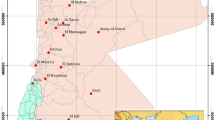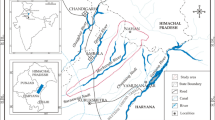Abstract
Groundwater quality assessment has been carried out based on physicochemical parameters (pH, EC, TDS, CO3, HCO3, Cl, SO4, PO4, NO2, Ca+2, Mg+2, Na+ and K+) and metal concentration in the Rameswaram Island from 25 bore wells. The Langelier Saturation Index of the groundwater shows positive values (63% samples) with a tendency to deposit the CaCO3 in the majority of water samples. Scatter plot (Ca + Mg/HCO3) suggests carbonate weathering process, which is the main contributor of Ca2+, Mg2+ and HCO3 ions to the water. Gibbs diagram suggests rock–water interaction dominance and evaporation dominance which are responsible for the change in the quality of water in the study area. NaCl and mixed CaNaHCO3 facies are two main hydrogeochemical facies of groundwater. Mathematical calculations and graphical plots of geochemical data reveal that the groundwater of Rameswaram Island is influenced by natural weathering of rocks, anthropogenic activities and seawater intrusion due to over exploitation. Weathering and dissolution of carbonate and gypsum minerals also control the concentration of major ions (Ca+2, Mg+2, Na+ and K+) in the groundwater. The nutrient concentration of groundwater is controlled to a large extent by the fertilizers used in agricultural lands and aquaforms. Comparison of geochemical data shows that majority of the groundwater samples are suitable for drinking water and irrigation purposes.









Similar content being viewed by others
References
APHA. (1995). Standard methods for the examination of water and waste water (19 th edn.). Washington D.C: American Public Health Association.
Ahmad Zaharin, A., Abdullah, M. H., & Woog, K. K. (2006). Hydrogeochemistry of groundwater in Manukan Island Malaysia. The Malaysian Journal of Analytical Sciences, 11(2), 407–413.
Ballukraya, P. N., & Ravi, R. (1999). Characterisation of groundwater in the unconfined aquifer of Chennai city, India. Journal of the Geological Society of India, 54, 1–11.
Billings, R. J., Berkowitz, R. J., & Watson, G. (2004). Teeth. Pediatrics, 113, 1120–1127.
Dajkumar, J.D. (2005). Genesis of beachrock formation along the southeastern coast of Tamil Nadu and its significance to sea level variations, Unpublished Ph.D thesis, Tamil University, Thanjavur.
Dixit, S., Gupta, S. K., & Tiwari, S. (2005). Nutrients overloading of a freshwater lake in Bhopal, India. Electronic Green Journal, 21, 2–6.
Domenico, P. A., & Schwartz, F. W. (1990). Physical and chemical hydrogeology. New York: Wiley.
Doneen, L.D. (1964). Notes on water quality in agriculture. Published in Water Science and Engineering, Univ. California, Davis.
Gibbs, R. J. (1970). Mechanism controlling world water chemistry. Sciences, 170, 795–840.
Gupta, S. K., & Gupta, I. C. (1987). Management of saline soils and water (p. 399). New Delhi India: Oxford and IBH Publication. Co.
ISI. (1983). Drinking water standard-substances or characteristic affecting the acceptability of water for domestic use. IS, 10500, 1–22.
Jacks, G. (1973). Chemistry of groundwater in a district in Southern India. Journal of Hydrology, 18, 185–200.
Jeevanandam, M., Kannan, R., Srinivasalu, S., & Rammohan, V. (2006). Hydrogeochemistry and groundwater quality assessment of lower part of the Ponnaiyar River Basin, Cuddalore District, South India. Environmental Monitoring and Assessment, 132(1), 263–274.
Krishna Kumar, S., Ram Mohan, V., Dajkumar Sahayam, J., & Jeevanandam, M. (2009). Assessment of groundwater quality and hydrogeochemistry of Manimuktha River basin, Tamil Nadu, India. Environmental Monitoring and Assessment, 159(1–4), 341–351.
Kulasekaran, A. & Balakrishnan, P. (2002). Status of fluoride in groundwater in Tamil Nadu, Chennai. Tamil Nadu Water Administrative Department.
Langelier, W. F. (1946). Chemical equilibria in water treatment. Journal of American Water Works Association, 38, 169.
Malini, S., Nagaiah, N., Paramesh, L., Venkataramaiah, P., & Balasubramanian, A. (2003). Groundwater quality around Mysore, Karnataka, India. International Journal of Environmental Studies, 60, 87–98.
Mohan, R., Singh, A. K., Tripathi, J. K., & Choudhry, G. C. (2000). Hydrochemistry and quality assessment of groundwater in Naini industrial area Allahabad District, Uttar Pradesh. Journal of the Geological Society of India, 55, 77–89.
Nativ, R., & Smith, A. (1987). Hydrogeology and geochemistry of the Ogallala aquifer Southern High Plains. Journal of Hydrology, 91, 217–253.
Obiri, S. (2007). Determination of heavy metals in water from boreholes in Dumasi in the Wassa West District of western region of Republic of Ghana. Environmental Monitoring and Assessment, 130, 455–463.
Piper, A. M. (1944). A graphical interpretation of water—analysis. Transactions of the American Geophysical Union, 25, 914–928.
Rajmohan, N., & Elango, L. (2004). Identification and evolution of hydrogeochemical processes in the groundwater environment in an area of the Palar and Cheyyar River Basins, Southern India. Environmental Geology, 46, 47–61.
Rajmohan, N., Elango, L., Ramachandran, S., & Natarajan, M. (2000). Major ion correlation in groundwater of Kancheepuram region, South India. Indian Journal of Environmental Protection, 20(3), 188–193.
Ramachandramoorthy, T., Sivakumar, V., & Subramanian, V. (2009). A seasonal quality assessment on portability of fresh shallow aquifers along the Rameswaram-Dhanuskodi coastal tract, India. Environmental Monitoring and Assessment, 159(1–4), 511–520.
Reddy, P. M., & Subbarao. (2001). Effect of industrial effluents on the groundwater regime in Vishakhapatnam. Pollution Research, 20(3), 383–386.
Suresh Babu, D. S., Hindi, E. C., Da Rosa Filho, E. F., & Bittencourt, A. V. L. (2002). Characteristics of Valadares Island aquifer, Paranagua coastal Plain, Brazil. Environmental Geology, 41, 954–959.
Todd, D. K. (1980). Groundwater hydrology (2nd ed., p. 535). New York: Wiley.
Tyagi, S. K., Datta, P. S., & Pruthi, N. K. (2009). Hydrochemical appraisal of groundwater and its suitability in the intensive agricultural area of Muzaffarnagar district, Uttar Pradesh, India. Environmental Geology, 56, 901–912.
USEPA (2002). National water quality inventory-2000 Report to Congress, U. E. P. Agency, EPA 841-R-02-001.
USSL (1954). Diagnosis and improvement of salinity and alkaline soil. USDA Hand Book no. 60, Washington.
Venugopal, T., Giridharan, L., Jayaprakash, M., & Periakali, P. (2009). Environmental impact assessment and seasonal variation study of the groundwater in the vicinity of River Adyar, Chennai, India. Environmental Monitoring and Assessment, 149, 81–97.
WHO (1971). Guidelines for drinking- water quality, VOL. 1 Recommendations, Geneva, p130.
Wilcox, L.V. (1955). Classification and use of irrigation waters, USDA Circular No. 969, pp19.
Acknowledgment
The authors are thankful to the Department of Science and Technology, New Delhi for providing financial support (grant no. SR/S4/ES-44/2003, dated: 01/11/2004) and senior author KK is thankful to Prof. A. Palavesam, Ramasubburayan, Iyapparaj, Esakkiraj—Centre for Marine Science and Technology, Manonmaniam Sundaranar University, Tirunelveli, Prakash—Department of Oceanography and Coastal Area studies, Alagappa University, Thondi and Vetrimurugan—Department of Geology, Anna University, Chennai for their kind support during the field work and laboratory analysis.
Author information
Authors and Affiliations
Corresponding author
Rights and permissions
About this article
Cite this article
Krishna Kumar, S., Chandrasekar, N., Seralathan, P. et al. Hydrogeochemical study of shallow carbonate aquifers, Rameswaram Island, India. Environ Monit Assess 184, 4127–4138 (2012). https://doi.org/10.1007/s10661-011-2249-6
Received:
Accepted:
Published:
Issue Date:
DOI: https://doi.org/10.1007/s10661-011-2249-6




